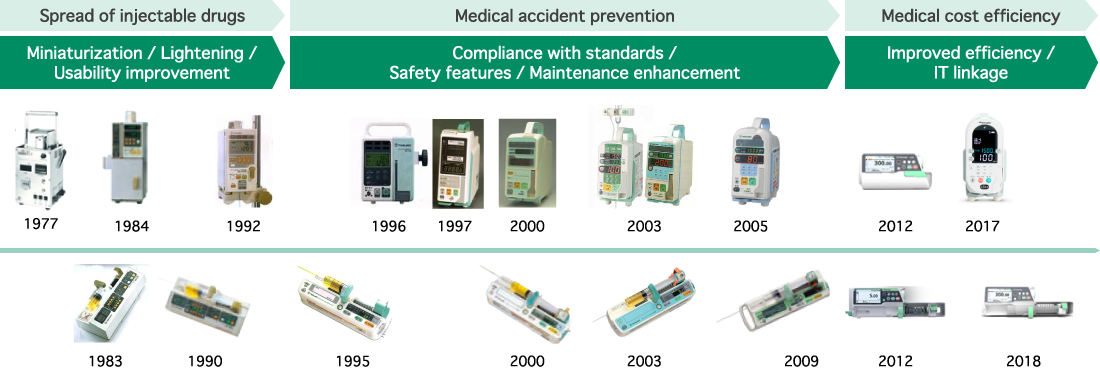 Top
TopTerumo pumps that sustain patients’ lives Continuous improvement to make healthcare safer
Infusion and syringe pumps are medical devices used to keep the fluids of patients in a healthy state during treatment and recovery. They are inserted into veins and, through catheters and infusion lines, provide patients with needed water, electrolytes and nutrition, as well as the anesthetics and circulatory drugs required during surgery, and other needed medicine. When hearing the term, most people probably think of an IV bag hung on a bar and directly connected to a patient. However, with this “natural drip” method, the height of the bed, characteristics of the drug, time of administration, and other factors can change the speed at which the patient receives the drug. For patients whose conditions require more precise drug administration in volume and time, infusion pumps and syringe pumps that can control flow rate are used.
Specifically, when a patient is treated for severe or acute illness in an operating room or intensive care unit (ICU), the process of drug administration is extremely complex. One patient may require emergency treatment, or there may be several patients to treat at once. There is a wide variety of drugs that must be correctly and safely handled. Records of administered drugs must also be carefully kept. All these things place an enormous burden on medical professionals.
Since launching the infusion pump in 1977 and the syringe pump in 1983, Terumo has supported the evolution of these products in medical settings in Japan and around the world. To reduce the risk of medical accidents occurring through the handling of devices and drugs, Terumo has spent decades working from the perspective of medical professionals toward making products safer and more functional, while also continuously improving their technology. With the top share of the market in Japan, Terumo has consistently contributed to the evolution of drug administration.

Evolution of healthcare needs and infusion/syringe pumps
IT linkage to hospital systems Infusion / syringe pump technological hurdles
With hospitals advancing technologically in recent years, Terumo has brought high-functionality drug infusion systems to the market which utilize ICT to link infusion and syringe pumps with IT systems, for things like operations and anesthesia. The pumps are also equipped with drug libraries (lists with correct dosage parameters for each drug) and wireless communications functionality for automatic recording of drug administration information and monitoring. This contributes to workflow efficiency and standardization in hospitals, as well as improvement of treatment safety.
When development to link infusion and syringe pumps with IT systems began in 2010, it was an unknown area for Terumo. Hospital IT systems for electronic medical records (Hospital Information System, or HIS) are well known; some literally digitalize and manage medical records, while others are used for billing, testing and treatment, nurse workflow support, and other things. Diverse kinds of IT systems are used in hospitals. There are also many vendors that build these systems for medical institutions. Installed electronic medical instruments for things like vital sign monitoring or anesthesia were the first to be IT-linked, and companies both developed and sold these devices. Terumo dealt with many unknown factors in this situation, including how to select a vendor or system to link with, or how to link with infusion or syringe pumps.
There were many technological hurdles to linking systems within a hospital. Because infusion and syringe pump numbers are increased or decreased depending on the patient situation, and because they are used by being moved to a variety of locations within a hospital, such as operating rooms, ICUs, and general wards, they have posed more complexity in linkage with IT systems than stationary installed instruments. In addition, they previously used only RS-232C (EIA-232-D/E), a data output method commonly used in medical devices and computer accessories. RS-232C is used widely because it is a simple and stable communications standard even amid the spread of USB and wireless LAN, and many other devices use this method to send data to systems. However, in linking pumps, the large number of devices and complexity of operations make it difficult to use the standard to link systems.

Diverse technologies come together to realize intelligent pumps
Assuming difficult conditions such as drug administration in complex emergency medical situations, and the linkage of many pumps, ME (Medical Engineering) device development teams set out in their design and programming work to achieve a pump with not only improved design and usability, safety features, and improvements to the actual pump functionality, but also the capability to link with hospital IT systems.
One team focused on developing a dedicated rack that unified the original RS-232C data output with power supply, while also enabling the simultaneous use of many linked pump units. To meet the increasing needs of medical settings to utilize IT to streamline work and prevent mistakes in drug administration, a team was created to do work including the addition of wireless and wired LAN communications, and development of drug library functions.
This was a challenge: To add to the mechanical aspects of the pump function and make it a technology-driven “intelligent pump.” Several times more engineers from inside and outside the company joined the work compared to previous products, and in 2012 the advanced infusion system with hospital IT linkage capability was born.

Beyond the age of monozukuri to create value through collaboration
Medical devices are only effective when used correctly. Terumo believes that the responsibility of a medical device manufacturer is not only to deliver products (things), but also to contribute to the lives of patients in each medical setting, and to the improvement of healthcare for which each medical professional strives. For Terumo infusion and syringe pumps to be used safely and efficiently in hospitals with diverse IT systems, collaboration with medical professionals who use devices and firms that provide IT systems is essential. Opportunities for this collaboration are increasing along with the acceleration of ICT evolution.
The COVID-19 crisis has served to further increase the meaning of ICT in medical settings. Ever-higher levels of needs are emerging for Terumo infusion and syringe pumps to fulfill. Terumo works every day to improve technology toward meeting these needs as rapidly as possible.













